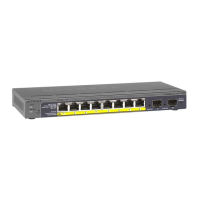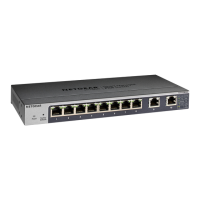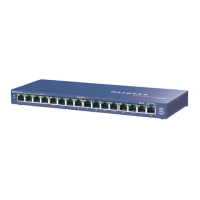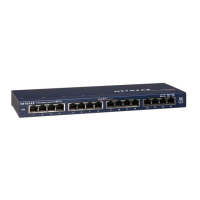8-Port Gigabit (PoE+) Ethernet Smart Managed Pro Switch with (2 SFP or 2 Copper Ports and)
Cloud Management
Configure System Information User Manual60
8. Determine how the switch acquires an IPv6 address:
• IPv6 Address Auto Configuration Mode. When this mode is enabled, the network
interface can acquire an IPv6 address through IPv6 Neighbor Discovery Protocol
(NDP) and through the use of router advertisement messages. When this mode is
disabled, the network interface does not use the native IPv6 address
auto-configuration features to acquire an IPv6 address. Auto-configuration can be
enabled only when DHCPv6 is not enabled on any of the management interfaces.
• DHCPv6. Next to Current Network Configuration Protocol, select the DHCPv6 radio
button to enable the DHCPv6 client on the interface. The switch attempts to acquire
network information from a DHCPv6 server. Selecting the None radio button disables
the DHCPv6 client on the network interface.
When DHCPv6 is enabled, the DHCPv6 Client DUID field displays the client identifier
used by the DHCPv6 client (if enabled) when sending messages to the DHCPv6
server.
9. In the IPv6 Gateway field, specify the default gateway for the IPv6 network interface.
The gateway address is in IPv6 global or link-local address format.
10. To configure one or more static IPv6 addresses for the management interface, do the
following:
a. In the IPv6 Prefix/Prefix Length field, specify the static IPv6 prefix and prefix to the
IPv6 network interface.
The address is in the global address format.
b. In the EUI64 menu, select True to enable the Extended Universal Identifier (EUI)
flag for IPv6 address, or select False to omit the EUI flag.
c. Click the Add button.
11. Click the Apply button.
Your settings are saved.
View the IPv6 network neighbors
You can view information about the IPv6 neighbors that the switch discovered through the
network interface by using the Neighbor Discovery Protocol (NDP).
To view the IPv6 Network Neighbor Table:
1. Connect your computer to the same network as the switch.
You can use a WiFi or wired connection to connect your computer to the network, or
connect directly to a switch that is off-network using an Ethernet cable.
2. Launch a web browser.
3. In the address field of your web browser, enter the IP address of the switch.
If you do not know the IP address of the switch, see Access the switch on-network and
connected to the Internet on page 19 or Access the switch off-network on page 30.

